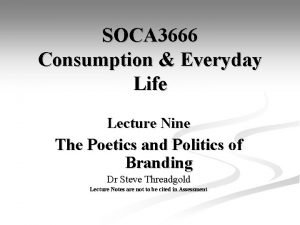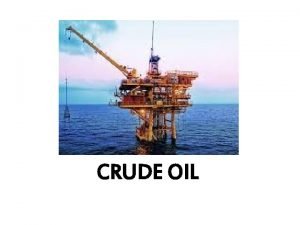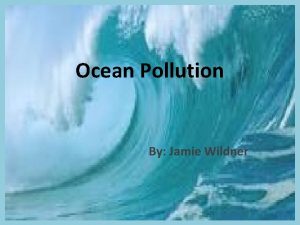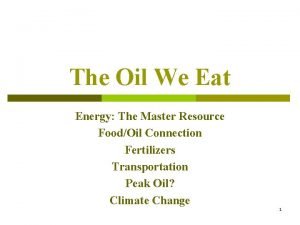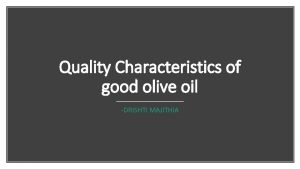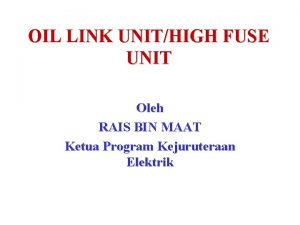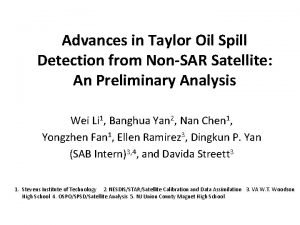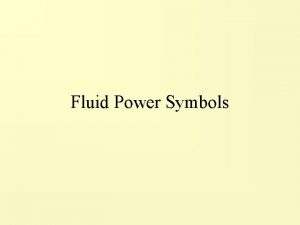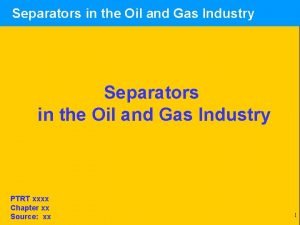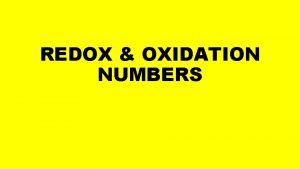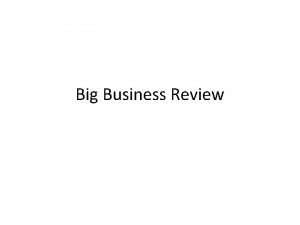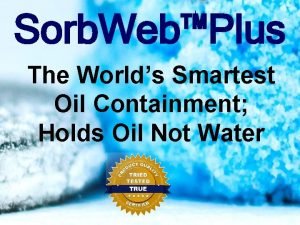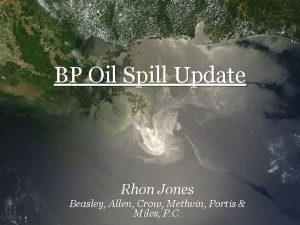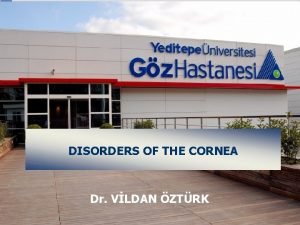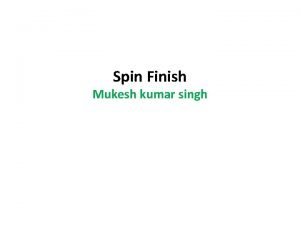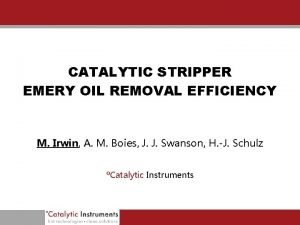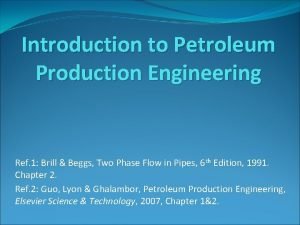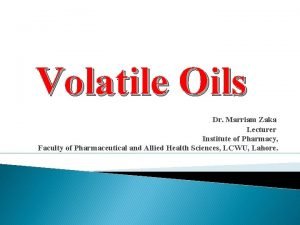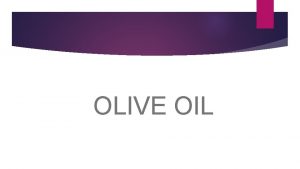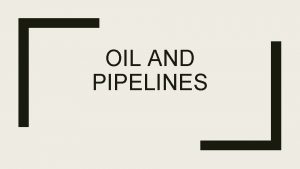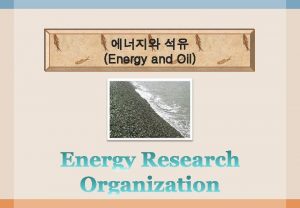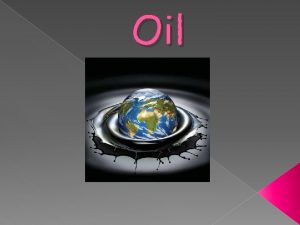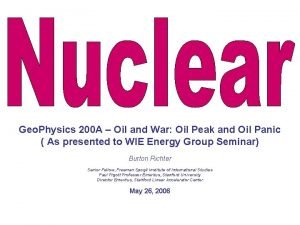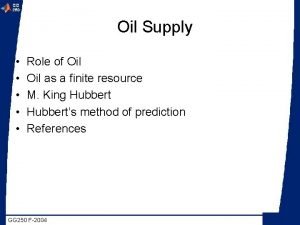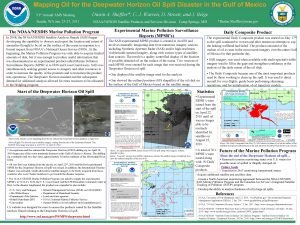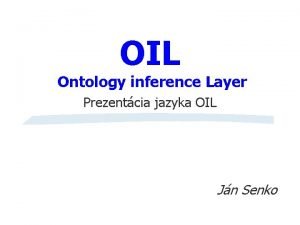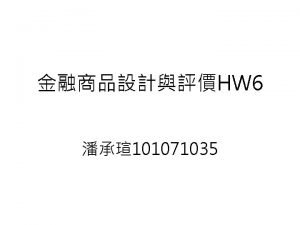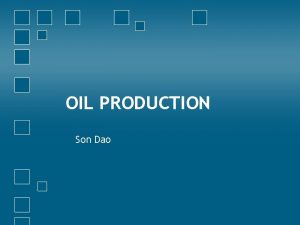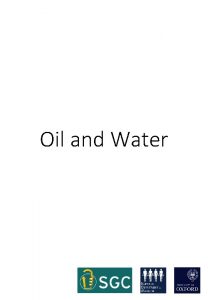Week 2 1 Week 2 2 oil oil





























![EXAMPLE: $1 X x p(x) Log[x] p(x) 0. 8 0. 3 -0. 029073 1. EXAMPLE: $1 X x p(x) Log[x] p(x) 0. 8 0. 3 -0. 029073 1.](https://slidetodoc.com/presentation_image_h/a176bca407658924d4e0f79f08797a30/image-30.jpg)


- Slides: 32

Week 2. 1

Week 2. 2

“oil” = oil is present “+” = a test for oil is positive - “ ” = a test for oil is negative + oil - no oil + - false negative false positive 3

P(oil) = 0. 3 P(+ | oil) = 0. 9 P(+ | no oil) = 0. 4 P(+ | oil) = 0. 9 P(oil) = 0. 3 + oil - no oil + - P(oil +) = (0. 3)(0. 9) = 0. 27 4

P(oil) = 0. 3 P(+ | oil) = 0. 9 P(+ | no oil) = 0. 4 0. 3 oil 0. 7 no oil 5

P(oil) = 0. 3 P(+ | oil) = 0. 9 P(- | oil) = 0. 1 P(+ | no oil) = 0. 4 0. 9 0. 3 oil 0. 1 0. 7 no oil + + - 6

P(oil) = 0. 3 P(+ | oil) = 0. 9 P(+ | no oil) = 0. 4 0. 3 oil 0. 7 no oil 0. 9 + 0. 1 0. 4 0. 6 - + - 0. 27 oil+ 0. 03 oil 0. 28 oil+ 0. 42 oil 7

S oil 0. 03 0. 27 0. 28 0. 9 + 0. 1 0. 3 oil + 0. 7 no oil 0. 4 0. 6 - + - 0. 42 0. 27 oil+ 0. 03 oil 0. 28 oil+ 0. 42 oil 8

0. 9 0. 3 oil 0. 7 no oil 0. 4 + + 0. 27 oil+ 0. 28 oil+ Oil contributes 0. 27 to the total P(+) = 0. 55. 9

S oil 0. 03 + 0. 27 0. 28 0. 42 0. 27 oil+ 0. 28 oil+ Oil contributes 0. 27 of the total P(+) = 0. 27+0. 28. 10

0. 01 disease 0. 98 0. 02 + 0. 99 no disease 0. 03 0. 97 + - The test for this infrequent disease seems to be reliable having only 3% false positives and 2% false negatives. What if we test positive? 11

0. 01 disease 0. 98 0. 02 + 0. 0098 - 0. 99 no disease 0. 03 0. 97 + 0. 0002 0. 0297 - 0. 9603 We need to calculate P(diseased | +), the conditional probability that we have this disease GIVEN we’ve tested positive for it. 12

0. 01 disease 0. 98 0. 02 + 0. 0098 - 0. 99 no disease 0. 03 0. 97 + 0. 0002 0. 0297 - P(+) = 0. 0098 + 0. 0297 = 0. 0395 P(disease | +) = P(disease+) / P(+) =. 0098 / 0. 0395 = 0. 248. 0. 9603 13

0. 01 disease 0. 98 0. 02 + 0. 0098 - 0. 99 no disease 0. 03 0. 97 + 0. 0002 0. 0297 0. 9603 EVEN FOR THIS ACCURATE TEST: P(diseased | +) is only around 25% because the non-diseased group is so predominant that most 14 positives come from it.

0. 001 disease 0. 98 0. 02 + 0. 00098 - 0. 999 no disease 0. 03 0. 97 + 0. 00002 0. 02997 - 0. 996003 WHEN THE DISEASE IS TRULY RARE: P(diseased | +) is a mere 3. 2% because the huge non-diseased group has completely over 15 whelmed the test, which no longer has value

FOR MEDICAL PRACTICE: Good diagnostic tests will be of little use if the system is overwhelmed by lots of healthy people taking the test. Screen patients first. FOR BUSINESS: Good sales people capably focus their efforts on likely buyers, leading to increased sales. They can be rendered ineffective by feeding them too many false leads, as with massive un-targeted sales promotions. 16

(3 -17 of text) 2 3 4 5 6 7 8 total probability 0. 2 0. 3 0. 1 0. 05 1 17

P(oil) = 0. 3 Cost to drill 130 Reward for oil 400 net return “just drill” -130 + 400 = 270 0. 3 drill oil drill no oil 0. 7 -130 + 000 = -130 no oil A random variable is just a numerical function 18 over the outcomes of a probability experiment.

Definition of E X = sum of value times probability x p(x). Key properties E(a X + b) = a E(X) + b E(X + Y) = E(X) + E(Y) (always, if such exist) a. E(sum of 13 dice) = 13 E(one die) = 13(3. 5). b. E(0. 82 Ford US + Ford Germany - 20 M) = 0. 82 E(Ford US) + E(Ford Germany) - 20 M 19 regardless of any possible dependence.

2 3 4 5 6 7 8 9 10 11 12 sum probability product 1/36 2/36 6/36 3/36 12/36 4/36 20/36 5/36 30/36 6/36 42/36 5/36 40/36 4/36 36/36 30/36 22/36 12/36 1 252/36 = 7 (3 -15) of text 20

(3 -17 of text) 2 3 4 5 6 7 8 total probability 0. 2 0. 3 0. 1 0. 05 1 product 0. 4 0. 6 1. 2 0. 5 0. 6 0. 35 0. 4 4. 05 21

Expected return from policy “just drill” is the probability weighted average (NET) return E(NET) = (0. 3) (270) + (0. 7) (-130) = 81 - 91 = -10. net return from policy“just drill. ” -130 + 400 = 270 0. 3 drill oil drill no-oil 0. 7 -130 + 0 = -130 no oil E(X) = -10 22

“costs” TEST 20 DRILL 130 OIL 400 0. 3 0. 7 A test costing 20 is available. This test has: P(test + | oil) = 0. 9 P(test + | no-oil) = 0. 4. oil no oil 0. 9 0. 1 + 0. 4 0. 6 + Is it worth 20 to test first? - 0. 27 0. 03 0. 28 0. 42 23

oil+ = -20 -130 + 400 = 250 0. 27 oil- = -20 - 0 + 0 = - 20. 03 no oil+ = -20 -130 + 0 = -150. 28 no oil- = -20 - 0 + 0 = - 20. 42 total 1. 00 67. 5 - 0. 6 - 42. 0 - 8. 4 16. 5 E(NET) =. 27 (250) -. 03 (20) -. 28 (150) -. 42 (20) = 16. 5 (for the “test first” policy). This average return is much preferred over the 24 E(NET) = -10 of the “just drill” policy.

x p(x) 2 0. 2 3 0. 2 4 0. 3 5 0. 1 6 0. 1 7 0. 05 8 0. 05 total 1. 00 quantity terminology x p(x) x 2 p(x) (x-4. 05)2 p(x) 0. 4 0. 8405 0. 6 1. 8 0. 2205 1. 2 4. 8 0. 0005 0. 5 2. 5 0. 09025 0. 6 3. 6 0. 38025 0. 35 2. 45 0. 435125 0. 4 3. 2 0. 780125 4. 05 19. 15 2. 7475 EX E X 2 E (X - E X)2 mean of squares (3 -17) of text variance = mean of sq dev s. d. = root(2. 7474) = root(19. 15 - 4. 052) = 1. 6576 25

Var(X) =def E (X - E X)2 =comp E (X 2) - (E X)2 i. e. Var(X) is the expected square deviation of r. v. X from its own expectation. Caution: The computing formula (right above), although perfectly accurate mathematically, is sensitive to rounding errors. Key properties: Var(a X + b) = a 2 Var(X) (b has no effect). sd(a X + b) = |a| sd(X). VAR(X + Y) = Var(X) + VAR(Y) if X ind of Y. 26

Random variables X, Y are INDEPENDENT if p(x, y) = p(x) p(y) for all possible values x, y. If random variables X, Y are INDEPENDENT E (X Y) = (E X) (E Y) echoing the above. Var( X + Y ) = Var( X ) + Var( Y ). 27

Venture one returns random variable X per $1 investment. This X is termed the “price relative. ” This random X may in turn be reinvested in venture two which returns random variable Y per $1 investment. The return from $1 invested at the outset is the product random variable XY. If INDEPENDENT, E( X Y ) = (E X) (E Y). 28

EXAMPLE: $1 X x 0. 8 1. 2 1. 5 p(x) x p(x) 0. 3 0. 24 0. 5 0. 60 0. 2 0. 30 E(X) = 1. 14 BUT YOU WILL NOT EARN 14%. Simply put, the average is not a reliable guide to real returns in the case of exponential growth. 29
![EXAMPLE 1 X x px Logx px 0 8 0 3 0 029073 1 EXAMPLE: $1 X x p(x) Log[x] p(x) 0. 8 0. 3 -0. 029073 1.](https://slidetodoc.com/presentation_image_h/a176bca407658924d4e0f79f08797a30/image-30.jpg)
EXAMPLE: $1 X x p(x) Log[x] p(x) 0. 8 0. 3 -0. 029073 1. 2 0. 5 0. 039591 1. 5 0. 2 0. 035218 E Log 10[X] = 0. 105311 100. 105311. . = 1. 11106. . With INDEPENDENT plays your RANDOM return will compound at 11. 1% not 14%. (more about this later in the course) 30

31

32
 Oral emulsion example
Oral emulsion example Week by week plans for documenting children's development
Week by week plans for documenting children's development Matt rosenzweig
Matt rosenzweig Dubai in 1960
Dubai in 1960 Oil spill
Oil spill Oil spill
Oil spill Naphtha uses
Naphtha uses Oil spill
Oil spill Press station palm oil mill
Press station palm oil mill The oil we eat
The oil we eat Drishti majithia
Drishti majithia High fuse unit
High fuse unit Oil rig biology
Oil rig biology Oil spill
Oil spill Unidirectional motor symbol
Unidirectional motor symbol Types of separators in oil and gas industry
Types of separators in oil and gas industry Oil spill
Oil spill How do oxidation numbers work
How do oxidation numbers work Industrialists of the late 1800s used pools and trusts to
Industrialists of the late 1800s used pools and trusts to Where was oil first discovered
Where was oil first discovered Ancap oil
Ancap oil Fossil fuels summary
Fossil fuels summary Transformer oil containment pit design
Transformer oil containment pit design Rhon jones beasley allen
Rhon jones beasley allen Advantages of using fossil fuels
Advantages of using fossil fuels Senile furrow degeneration cornea
Senile furrow degeneration cornea Spin finish oil formulation
Spin finish oil formulation Oil and gas free zone authority recruitment
Oil and gas free zone authority recruitment Canola oil
Canola oil Catalytic stripper
Catalytic stripper Black oil properties
Black oil properties What is volatile oil in pharmacognosy
What is volatile oil in pharmacognosy Sewing machine target
Sewing machine target





